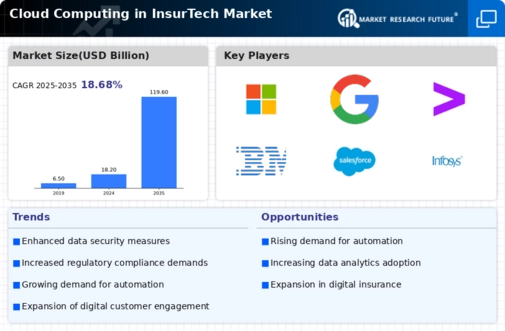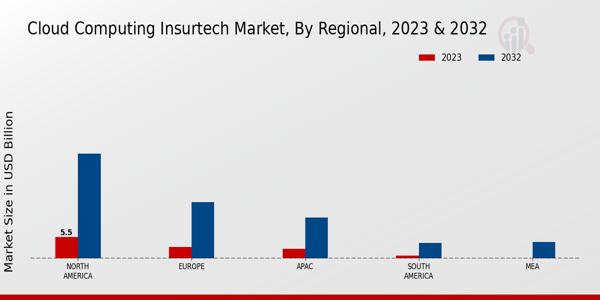Market Growth Visualization
The Global Cloud Computing in InsurTech Market Industry is poised for substantial growth, with projections indicating a market size of 18.2 USD Billion in 2024 and an impressive increase to 119.6 USD Billion by 2035. This growth trajectory reflects a compound annual growth rate (CAGR) of 18.68% from 2025 to 2035, highlighting the increasing adoption of cloud technologies within the insurance sector. The market dynamics suggest a shift towards digital solutions that enhance efficiency, security, and customer engagement, positioning cloud computing as a cornerstone of future innovations in InsurTech.
Cost Efficiency and Scalability
Cost efficiency and scalability are critical factors influencing the Global Cloud Computing in InsurTech Market Industry. Cloud solutions enable insurance companies to reduce operational costs by eliminating the need for extensive on-premises infrastructure. This shift allows for more flexible resource allocation and the ability to scale services according to demand. As a result, insurers can optimize their expenditures while enhancing service delivery. The anticipated growth of the market to 119.6 USD Billion by 2035 suggests that organizations are increasingly recognizing the financial benefits of cloud adoption, which supports long-term sustainability and growth.
Enhanced Data Analytics Capabilities
Enhanced data analytics capabilities are transforming the Global Cloud Computing in InsurTech Market Industry. Insurers are leveraging cloud-based analytics tools to gain insights from vast amounts of data, enabling them to make informed decisions and tailor products to customer needs. The ability to analyze trends and customer behavior in real-time allows for more personalized offerings and improved risk assessment. This trend is likely to drive further investment in cloud solutions, as companies seek to harness the power of data to enhance their competitive positioning in the market.
Regulatory Compliance and Data Security
Regulatory compliance and data security remain pivotal drivers in the Global Cloud Computing in InsurTech Market Industry. Insurers are mandated to adhere to stringent regulations regarding data protection and privacy. Cloud computing offers robust security measures, including encryption and access controls, which help organizations meet compliance requirements. As the industry evolves, the need for secure data handling becomes paramount, prompting insurers to invest in cloud solutions that ensure regulatory adherence. This focus on security not only protects sensitive customer information but also fosters trust, which is essential for maintaining competitive advantage in the market.
Increased Demand for Digital Transformation
The Global Cloud Computing in InsurTech Market Industry experiences heightened demand for digital transformation as insurance companies seek to modernize their operations. This shift is driven by the need for enhanced customer experiences and streamlined processes. In 2024, the market is projected to reach 18.2 USD Billion, reflecting a growing recognition of the benefits of cloud solutions. Insurers are increasingly adopting cloud technologies to improve data management, automate claims processing, and facilitate real-time analytics. This trend indicates a significant pivot towards innovative solutions that enhance operational efficiency and customer satisfaction.
Collaboration and Innovation through Cloud Ecosystems
Collaboration and innovation through cloud ecosystems are emerging as vital drivers in the Global Cloud Computing in InsurTech Market Industry. By utilizing cloud platforms, insurers can collaborate with technology providers and startups to develop innovative solutions that address evolving customer demands. This collaborative approach fosters a culture of innovation, enabling companies to rapidly adapt to market changes. The anticipated CAGR of 18.68% from 2025 to 2035 indicates a robust growth trajectory, suggesting that the industry is poised to embrace new technologies and partnerships that enhance service offerings and operational capabilities.















